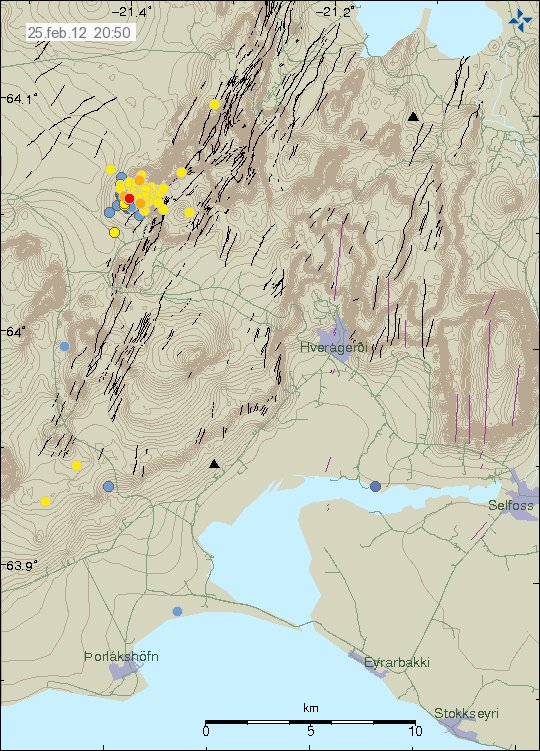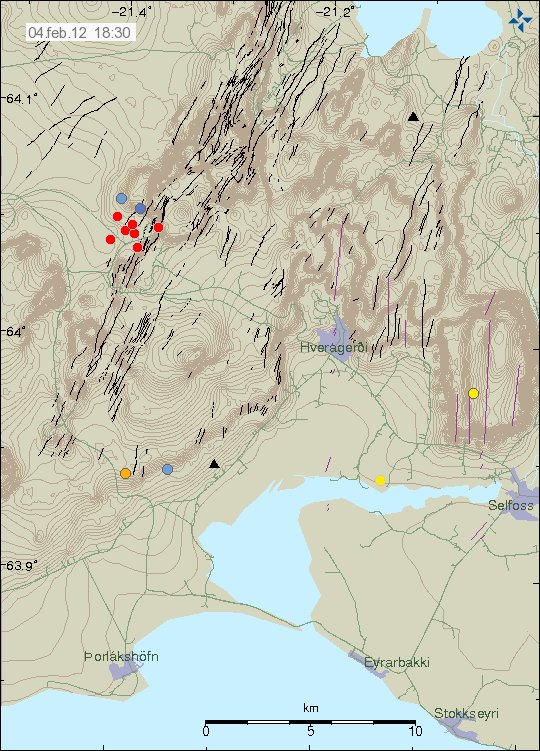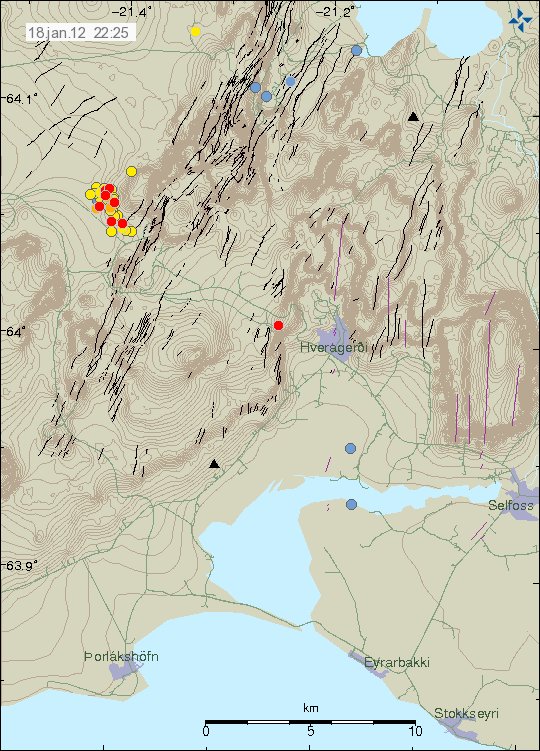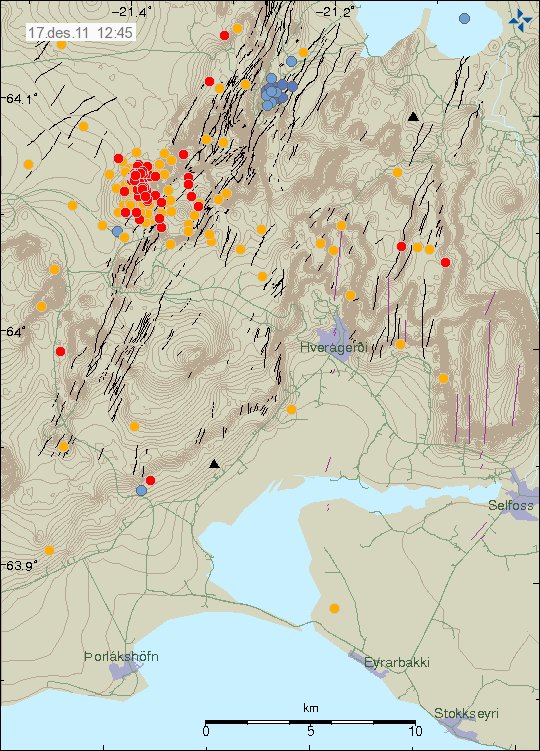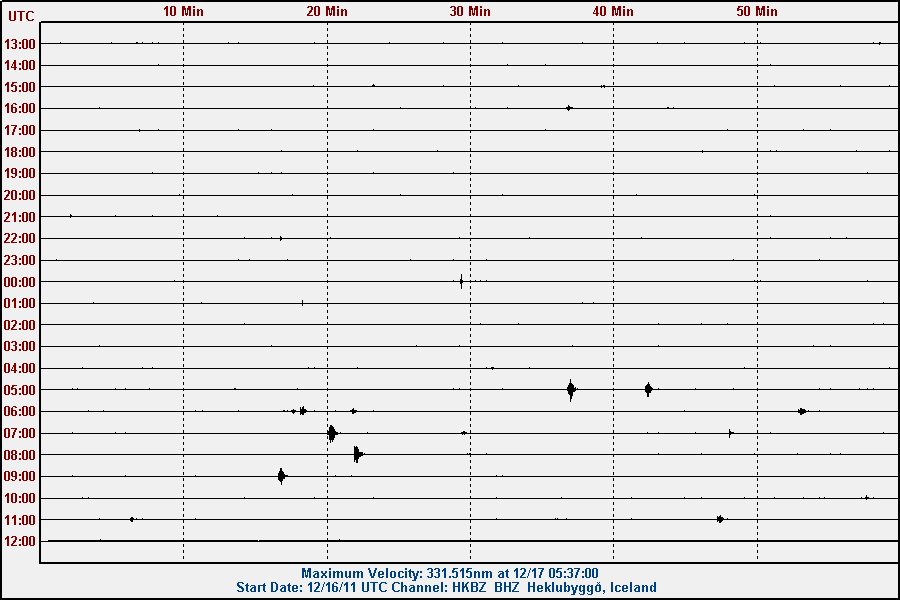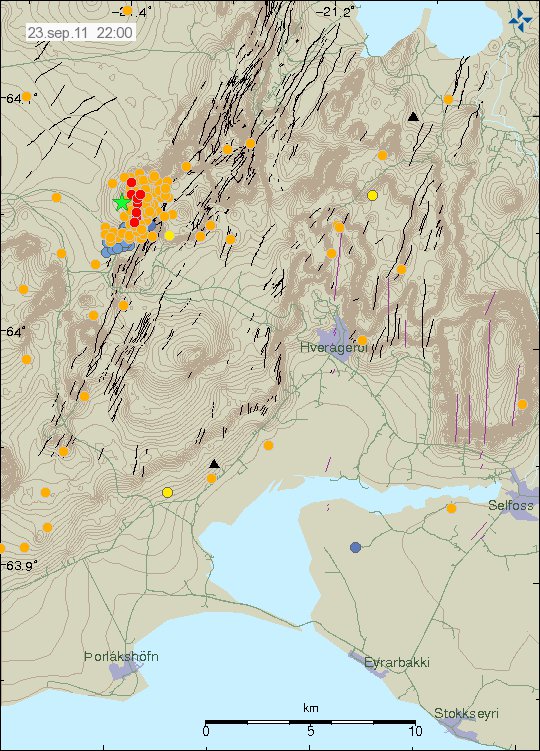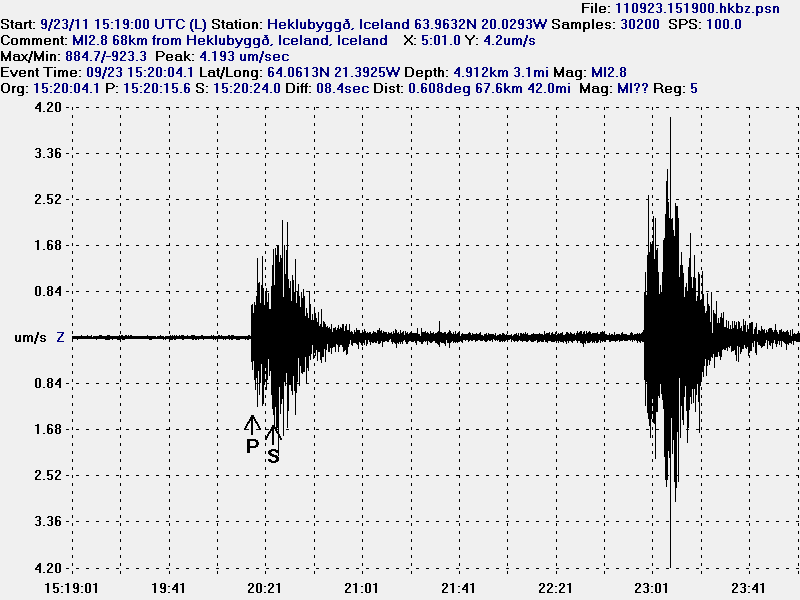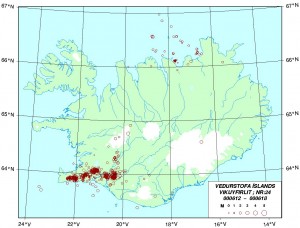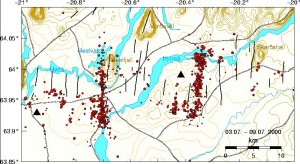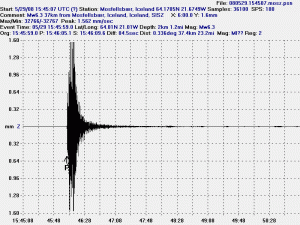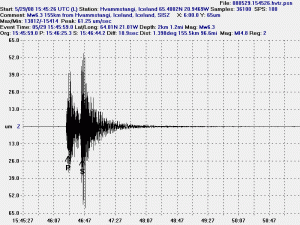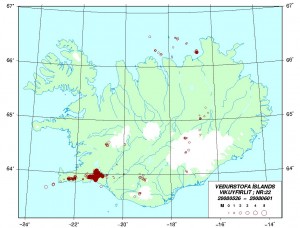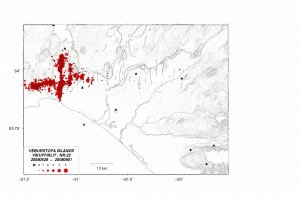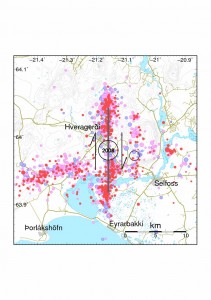Here is a short list of known eruptions in Iceland since the year 900 (or around that time). There might be missing eruptions because of lack of historical data. This list might not be completed from the reference that I am using.
Year of eruption
Year ~870. Ash and lava flow eruption in Vatnaöldum. Settlers ash layer is created in Iceland.
Year ~900. Creation of a lava field named Afstapahraun.
Year ~900 – ?. Somewhere in Vatnajökull glacier.
Year ~900. Krafla volcano erupts.
Year ~900. Hallmundarhraun lava field is created.
Year ~900. Rauðhálshraun lava field in Hnappadal is created.
Year ~905 – ?. Somewhere in Vatnajökull glacier.
Year ~920. Somwhere on the Reykjanes ridge. Location is unknown. But a ash layer is known from this eruption.
Year ~920. Katla volcano eruption. Ash layer named Katla-R.
Year ~934. Katla volcano creates Eldgjá volcano fissure. Lava flow from Eldgjá volcano fissure flows over Álftaver, Meðalland and Landbrot. Mýrdalssandur is sad to have been created in this eruption by a big flood from Mýrdalsjökuli following this eruption.
Year ~940. In Vatnajökull glacier or in Veiðivötnum. Ash from this eruption has been found in north-east Iceland.
Year 999 or 1000. Svínahraun lava field is created in a volcano eruption.
Year ~1000. Katla volcano eruption. Ash layer has been found. There is a written account of the flood that followed this eruption.
Year ~1060. Somewhere in Vatnajökli glacier.
Year 1104. Hekla volcano erupts it’s first documented eruption in Iceland. This eruptions sends ash to north and north-east. The valley of Þjórsárdalur is destroyed by volcano ash in this eruption.
Year 1151. Krýsuvík volcano erupts. This eruption creates the lava field Ögmundarhraun and Kapellahraun lava field. Trölladyngja is also created in this eruption.
Year 1158. Eruption in Hekla volcano.
Year ~1160. Somewhere in Vatnajökull glacier.
Year 1160 – 1180. Eruption on the Reykjanes Ridge. Two eruptions on the Reykjanes Ridge. Ash layer is known from this eruption.
Year 1179. Katla volcano eruption. Written accounts are unclear. But ash from this eruption has been found in Greenland glacier.
Year 1188 – ?. Rjúpnadyngjuhraun and Mávahlíðarhraun lava fields are created.
Year 1206. Hekla volcano erupts.
Year 1210 – 1211. Volcano eruption on the Reykjanes Ridge. Eldey is created in this eruption.
Year 1222. Hekla eruption.
Year 1223. Volcano eruption on the Reykjanes Ridge. Location unknown.
Year 1225. Volcano eruption on the Reykjanes Ridge. Location unknown.
Year 1226 – 1227. Several volcano eruptions on the Reykjanes. The following lava fields are belvied to have been created in this eruption, Younger Stampahraun, (Klofningahraun), Eldvarpahraun, Illahraun and Arnarseturshraun. At the same time a large ash eruption takes place at Reykjanestá. The middle age ash layer is created in this volcano eruption. This volcano eruption created a lot of problems for the local population.
Year 1231. Volcano eruption on the Reykjanes Ridge. Location unknown.
Year 1238. Volcano eruption on the Reykjanes Ridge. Location unknown.
Year 1240. Volcano eruption on the Reykjanes Ridge. Location unknown.
Year 1245. Volcano eruption in Katla volcano. This eruptions comes up at Sólheimajökli. Flood follows this eruption.
Year 1262. Volcano eruption in Katla volcano. This eruption is in Sólheimajökli. It creates a flood and is followed by a heavy ash fall.
Year 1300 – 1301. Hekla volcano eruption. A lot of ash fall in Skagafjöður, a famine followed this eruption due to ash fall.
Year 1311. A volcano eruption in Katla volcano. Heavy ash fall in east of Iceland (austfjörðum). A big flood followed this eruption, it was most likely on Mýrdalssandi. But written accounts are unclear and unreliable on what did happen.The following year was followed by a famine with death of both people and animals due too volcano ash.
Year 1332. A volcano eruption in Vatnajökli glacier. Most likely in Grímsfjall volcano.
Year 1340 – ?. Eruption in Brennisteinsfjöllum volcano. But no lava field from 14th century have been found however.
Year 1341. Hekla volcano eruption. Heavy ash fall. The ash did go to Borgarfjörð and Akranes. A lot of animal did die. Many farms in Rangárvöllum where abandoned following this eruption.
Year 1341 – ?. Grímsfjall volcano erupts.
Year 1354 – ?. Grímsfjall volcano erupts.
Year 1357. A large eruption in Katla volcano. A lot of damage.
Year 1362. A large eruption in Öræfajökull volcano. It did destory the county of Litla-Hérað and most likely all people how lived there did die. Most of the ash fall was into the ocean. But some of it did go to Hornafirði and in Lónshverfi. A glacier flood did go down Skeiðársand and out to the ocean.
Year 1372. North-west of Grímsey.
Year 1389 – 1390. Around Hekla volcano. Several farms did go under lava field in this eruption.
Year 1416. Eruption in Katla volcano.
Year 1422. Eruption somewhere off the Reykjanes. Creates a island that lasts for few years.
Year 1440. Eruption in or around Hekla volcano.
Year 1477. Volcano eruption on a long fissure in Veiðivötnum lakes and it reaches the western part of Vatnajökull glacier.
Year ~1480 – ~1500. Katla volcano has eruption. Few written accounts of this eruption.
Year ~1500. Somewhere in Vatnajökli glacier.
Year 1510. A large eruption in Hekla volcano. This eruption creates the largest known historical lava field from Hekla volcano. A heavy ash fall too the south takes place. A lot of destruction in Rangarvallársýsla follows it.
Year 1554. A eruption South-West of Hekla volcano. This eruption lasts about six weeks. Created craters called Rauðubjallar and from them a lava field called Pálssteinshraun.
Year 1580. Katla volcano erupts.
Year ~1582. Somewhere close to Eldey is a eruption.
Year 1597. A eruption in Hekla volcano started 3. January. Ash fall did happen but did not create a lot of damage.
Year 1598. Eruption in Grímsfjall volcano.
Year 1603. Eruption in Grímsfjall volcano.
Year 1612. Eruption in Katla volcano and Eyjafjallajökull volcano. A volcano eruption did start on 12. October in Katla volcano. But it unclear when the eruption did start in Eyjafjallajökull volcano.
Year 1619. Eruption in Grímsfjalla volcano.
Year 1625. Eruption starts in Katla volcano. The eruption started on the 2. September and it ended on the 25. September. This was a large eruption that did destroy 25 farms. Most the ash fall was to the east in this eruption. First report about volcano eruption is written in about this eruption.
Year 1629. Eruption in Grímsfjall volcano.
Year 1636 – 1637. Eruption in Hekla volcano starts 8. May and is ongoing for about one year. Little ash and little damage from this volcano eruption.
Year 1637 – 1638. Eruption somewhere in the neighbourhood of Vestmannaeyjar volcano.
Year 1638. Eruption in Grímsfjall volcano.
Year 1655. Eruption somewhere in Vatnajökull glacier. Most likely in Kverkfjöllum volcano. A large glacier flood took place in Jökulsá á fjöllum.
Year 1659. Eruption in Grímsfjall volcano.
Year 1660 – 1661. Katla volcano eruption did start on the 3. November and lasted over the new year. Not a lot of ash fall. But a large glacier flood. It did destroy the farm called Höfðabrekka.
Year 1681. Somewhere in Vatnajökuli glacier.
Year 1684 – 1685. Eruption in Grímsfjall volcano. A large glacier flood in Jökulsá á fjöllum. One man did die along with large number of livestock.
Year 1693. Volcano eruption in Hekla volcano. This eruption did start on the 13. February. A lot of the ash did go to north-west. The ash fall did create a heavy damage in the nearby area.
Year 1693. Katla volcano erupts.
Year 1697. Eruption somewhere in Vatnajökull volcano glacier.
Year 1702. Eruption somewhere in Vatnajökull volcano glacier.
Year 1706. Eruption somewhere in Vatnajökull volcano glacier.
Year 1711 – 1712. Eruption in Kverkfjöll volcano.
Year 1721. Eruption in Katla volcano. Heavy ash fall, volume of ash is estimated 1 km³ and large glacier flood follows this eruption.
Year 1724 – 1729. Krafla volcano eruption. This eruption creates the crater Víti when lava did flow into Mývatn.
Year 1725. Eruption somewhere in Vatnajökull volcano glacier.
Year 1725. Eruption takes place south-east of Hekla volcano.
Year 1726. Eruption somewhere in Vatnajökull volcano glacier.
Year 1727. Volcano eruption in Öræfajökull volcano. Three people did die in this eruption.
Year 1729. Volcano eruption in Kverkfjöll volcano.
Year 1746. Volcano eruption in Krafla volcano. Only one eruption documented.
Year 1753. Eruption takes place south-west of Grímsfjall volcano.
Year 1755 – 1756. A eruption starts in Katla volcano on the 17. October. A heavy ash fall that is estimated to have been 1,5 km³ drifts to the north-east and creates heavy damage in it’s path. A large glacier flood goes down Mýrdalssand. It flows mostly west of Hafursey. Two men die due to lightning strike. About 50 farms where abounded temporary due to this eruption.
Year 1766. Eruption in the western part of Vatnajökull glacier. Most likely in Bárðarbunga volcano.
Year 1766. Volcano eruption in Hekla volcano. The ash cloud drifts to Húnaþings counties and Skagafjarðar. Ten farms where abandoned following this eruption due to the ash cloud.
Year 1774. Volcano eruption in Grímsfjall volcano.
Year 1783. Eruption on the Reykjanes Ridge. Creates a new island named Nýey. It is not far from Eldey. But it disappears soon after it’s creation.
Year 1783 – 1784. Skaftáreldar take place. A long with a eruption in Grímsfjall volcano. Lava flows over a area of the size 580 km². Volcano gasses and did create famine and shortage of green grass for live stock around most of Iceland. Effects of this eruption was felt over in Europe and most of northern hemisphere.
Year 1797. Volcano eruption in Grímsfjall volcano.
Year 1807. Volcano eruption in Grímsfjall volcano.
Year 1816. Volcano eruption in Grímsfjall volcano.
Year 1821. Volcano eruption in Katla volcano.
Year 1821 – 1823. Volcano eruption in Eyjafjallajökull volcano. This eruption started on the 19. December and was mostly ash fall. A glacier flood did go down Markarfljót.
Year 1823. Eruption somewhere in Vatnajökull glacier.
Year 1830. Eruption takes place somewhere in the area of Eldeyjarboða.
Year 1838. Eruption in Grímsfjall volcano.
Year 1845 – 1846. Eruption starts in Hekla volcano on the 2. September. A lava flow covers 25 km² area. Heavy ash fall follows this eruption. The farm Næfurholt was moved following this eruption.
Year 1854. Eruption in Grímsfjall volcano.
Year 1860. Eruption in Katla volcano. This eruption is small.
Year 1861. Most likely a eruption in Grímsfjall volcano that year. But it is uncertain.
Year 1862 – 1864. A eruption starts on the 15 km long fissure north of Tungnaárjökuls. It creates a crater rows called Tröllagígar and a lava field called Tröllahraun. The volcano responsible for this eruption is Bárðarbunga volcano.
Year 1867. Volcano eruption in Grímsfjall volcano.
Year 1867 – 1868. Volcano eruption around or creates Mánareyjar.
Year 1872. Eruption somewhere in Vatnajökull glacier.
Year 1873. Volcano eruption in Grímsfjall volcano.
Year 1874. Askja volcano erupts. Eruption may have started in February, when steam clouds where first seen.
Year 1875. Askja volcano erupts. A lava eruption did start on 3. January. A caldera starts to form later in January following this eruption.
Year 1875. A 25 km long fissure opens 18. February and lasted until middle of August. This is believed to be a dike intrusion from Askja volcano that did get up to the surface.
Year 1875. The largest eruption in history of Iceland started on the 28. March and lasted for about 8 hours. In this eruption the crater Víti erupted and other caters. There was a heavy ash fall in east of Iceland. This did destroy many farms in the east of Iceland. The Askja lake was created in this eruption. Many other eruption where documented in the following months.
Year 1876. The eruption from Askja volcano is believed to have ended in that year.
Year 1876. Eruption somewhere in Vatnajökli glacier.
Year 1878. Eruption in Krakártindur east of Hekla volcano.
Year 1879. Eruption close to Geirfulgasker.
Year 1883. Volcano eruption in Grímsfjall volcano.
Year 1884. Somewhere around Eldey. Poorly documented.
Year 1885. Most likely a eruption in Grímsfjall volcano. But it is poorly documented.
Year 1887. Eruption in Grímsfjall volcano.
Year 1889. Eruption in Grímsfjall volcano.
Year 1892. Eruption in Grímsfjall volcano.
Year 1896. Eruption most likely south of Vestmannaeyjar volcano.
Year 1897. Eruption in Grímsfjall volcano.
Year December 1902 – June 1903. Eruption in Bárðarbunga volcano. Eruption possibly in Dyngjuháls, exact location is unknown.
Year 1902 – 1904. Eruption in Grímsfjall volcano.
Year 1905 – 1906. Eruption in Grímsfjall volcano.
Year 1908 – 1908. Eruption in Grímsfjall volcano.
Year 1910 June 18 – October 1910. Eruption in Loki-Fögrufjöll (Hamarinn volcano).
Year 1910. Eruption in Grímsfjall volcano. Ash fall is documented from June to November in east of Iceland.
Year 1913. Eruption east of Hekla volcano in a area named Mundafell / Lambafell.
Year 1918. Katla volcano erupts. This eruption started 12. October and did finish 5. November. The ash cloud did go up to 14,3 km high into the air. A large glacier flood did go down Mýrdalssand. People was in danger. A lot of live stock got lost.
Year 1921. Askja volcano. Small fissure eruption.
Year 1922. Askja volcano. Small fissure eruption.
Year 1922. Grímsfjall volcano started erupting in September. This eruption did finish in less then a month.
Year 1923. Askja volcano. Small fissure eruption.
Year 1923. Grímsfjall volcano eruption. Small eruption.
Year 1926. Askja volcano eruption. Creates a small island in Öskjuvatni lake.
Year 1926. Around Eldey. Boiling ocean reported for few hours.
Year 1927. Around Esjufjöll volcano. Minor eruption. A glacier flood from Breiðarmerkujökli glacier that killed one person.
Year 1929. Askja volcano eruption possible. But poorly documented and uncertain because of that.
Year 1929. Eruption in Kverkfjöll volcano. The volcano eruption was observed during the summer.
Year 1933. Minor eruption in Grímsfjall volcano.
Year 1934. Eruption started in the middle March and lasted until middle of April in Grímsfjall volcano.
Year 1938. Eruption in Grímsfjall volcano. Was on the north part of the caldera. But did not break trough the glacier ice.
Year 1941. Eruption might have taken place in Grímsfjall volcano.
Year 1945. Eruption might have taken place in Grímsfjall volcano.
Year 1947 – 1948. A eruption starts in Hekla volcano on the 29. March. The ash cloud goes up to 30 km. The ash cloud goes to the south. The lava flow had the size of 0,8 km³. Most of it did go the west and south-west from Axlargýg.
Year 1954. Possible eruption in Grímsfjall volcano.
Year 1955. Possible small eruption in Katla volcano. Small glacier flood from Mýrdalsjökli.
Year 1961. A fissure eruption started on the 26. October in Askja volcano on a 300 meter long fissure.
Year 1963 – 1967. Eruption in the Vestmannaeyjar volcano system. Surtsey island is formed south of Geirfulgaskeri. Few smaller island are also created. But disappear quickly.
Year 1970. Eruption in Hekla volcano started on 5. May. Most of the ash fall was to NNW and into Húnavatnssýslur. The eruption the mountain only lasted for few days. But the eruption in Skjólkvíum the eruption lasted for about two months.
Year 1973. A volcano eruption starts in Vestmanneyjar volcano. A 1600 meter long fissure opens close to the town of Vestmanneyjar. About the third of the town did go under lava and about 400 houses where destroyed. This created Eldfell and Heimaey did grow to the east.
Year 1975. Krafla volcano eruption starts on 20. December. A short fissure opens on close to Leirhnjúk.
Year 1977. Krafla volcano eruption starts on 27. April, it ends on 29. April.
Year 1977. Krafla volcano erupts. Eruption starts on 8. September, it ends on 9. September.
Year 1980. Krafla volcano erupts on 16. March.
Year 1980. Krafla volcano erupts. Volcano erupts starts on 10. July, it sends on 18. July.
Year 1980. Krafla volcano erupts. The eruption starts on 18. October and is to 23. October.
Year 1981. Krafla volcano erupts. The eruption starts on 30. January and it sends on 4. February.
Year 1981. Krafla volcano erupts. The eruption starts on 18. November. It ends on 23. November.
Year 1980 – 1981. Hekla volcano erupts. The eruption started on 17. August, it lasted until 20. August. The eruption did resume on the 9. April the year later (1981) and did most likely end on 18. April.
Year 1983. Eruption in Grímsfjall volcano in the end of May.
Year 1984. A most likely a minor eruption in Grímsfjall volcano.
Year 1984. Eruption in Krafla volcano. It starts on 4. September and it sends 18. September.
Year 1985. Most likely a minor eruption in Lokahrygg in Vatnajökli glacier. Harmonic tremor is recorded and a caldera forms in the glacier.
Year 1991. Eruption starts in Hekla volcano on the 17. January. The power of the eruption quickly vanish. One crater remains active until 17. March. Little ash was in this eruption. Considerable amount of lava did flow south of Hekla volcano.
Year 1996. Eruption on a fissure between Bárðarbunga volcano and Grímsfjall volcano. This eruption started on 30. September on a 4 to 5 km long fissure. This eruption lasted until 30. October. The earthquake swarm did indicate the dike intrusion from Bárðarbunga volcano. Water that was melted in this eruption did flow to Grímsvatna in Grímsfjall volcano. The drain did happen on 5. November.
Year 1998. Volcano eruption in Grímsfjall volcano did start on 18. December. It lasted until 28. December.
Year 1999. Small volcano eruption takes place in Sólheimajökli glacier in the Katla volcano. Small glacier flood follows. The eruption does not break the surface of the glacier ice. This happens on 17. July. Earthquake swarm follows this event with largest earthquakes that are up to ML3.0 in size. Harmonic tremor is seen on seismometers around Katla volcano.
Year 2000. Eruption did start in Hekla volcano on the 26. February. It lasted until 8. March. Little ash did follow this eruption. Lava flow was not considerable large.
Year 2004. Eruption did start in Grímsfjall volcano on 4. November.
Year 2010. Eruption starts in Eyjafjallajökull volcano after a large earthquake swarm in it. The first phase of the eruption takes place in Fimmvörðuhálsi when a eruption starts there on 20. March. A eruption starts in the main crater on Eyjafjallajökull volcano on 14. April. A ash clouds follows it along with a glacier flood that goes down Markarfljót. Some damage takes place in this eruption the nearby area of Eyjafjallajökull volcano.
Year 2011. Largest eruption in 140 years Grímsfjall volcano start on May 21. It ended on May 25. The ash cloud coming from the eruption was the largest one in the past 140 years from Grímsfjall volcano. No glacier flood did take place in this eruption. The eruption started around 17:30 UTC. But the first steam cloud was not observed until around 18:32 UTC. The ash cloud did reach the hight of 20 km. But did soon drop down to 10 km. Three days after the eruption did start it did loose power at fast rate and was over on May 25.
Year 2011: Katla volcano had a subglacier eruption in July. This is the second eruption of the year 2011 in Iceland. A glacier flood followed this minor eruption of Katla volcano. The eruption started on 8th of July and ended on 9th July.
Year 2011: Hamarinn volcano might have (most likely) had a eruption week after Katla volcano. Glacier flood followed this minor eruption of Hamarinn volcano. The eruption ended 13 July. Total eruption time was around 12 to 14 hours.
Year 2014.
Bárðarbunga volcano
- Two eruptions in the period of 16 – 22-August-2014. Exact time and date not known at the moment. Each eruption lasted for up to 24 hours at most.
- Eruption 23-August-2014 under the glacier. Lasted for ~6 hours.
- Eruption 29-August-2014 in Holuhraun. Lasted for ~4 hours.
- Eruption 31-August-2014, it ended on 27-Februar-2015. It lasted for almost 6 months.
- It is not clear how many minor eruptions have taken place under the glacier. Only documented eruptions are mentioned.
Year 2017
Katla volcano.
Start date: 29-July
End date: 29-July
A minor eruption took place in Katla volcano during the night of 29-July. It only lasted for 2 to 3 hours and was not visible and did not break trough the glacier. This eruption was only observed on harmonic tremor data from Icelandic Met office.
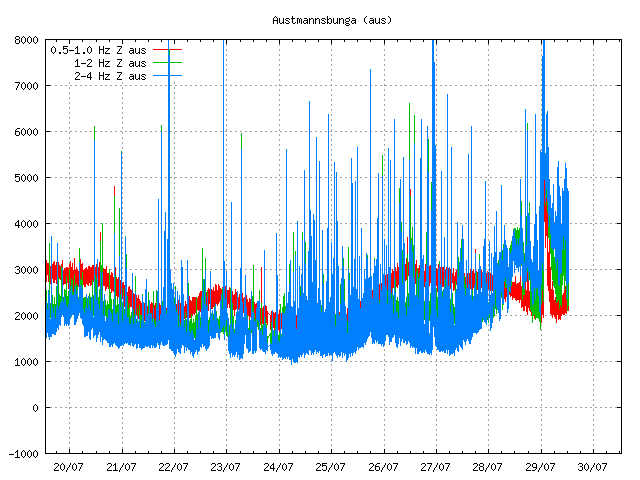
The minor eruption in Katla volcano as it appeared on harmonic tremor data on Icelandic Met Office SIL station. Copyright of this image belongs to Icelandic Met Office.
Before and after this even a small glacier flood appeared in Múlakvísl glacier river that comes from Mýrdalsjökull glacier. That glacier flood ended in the early mornings of 30-July-2017.
——-
This is the list of eruptions so far. It is not free of errors or typos. I am also going to update this list on a later date if I have to. As it is incomplete in regards to number of volcanoes mentioned in him.
Reference.
Eldgosaannáll Íslands (Wiki, Icelandic)
2010 eruptions of Eyjafjallajökull (Wiki)
Ármann Höskuldsson. „Hvert er öflugasta eldgos á Íslandi sem vitað er um?“. Vísindavefurinn 15.10.2010. http://visindavefur.is/?id=57031. (Skoðað 3.4.2011). (Icelandic)
Text is updated at 01:21 UTC on 4. April 2011. Error corrections to the list.
Text updated at 28. June 2011 at 22:34 UTC. Added Grímsfjall volcano eruption to the list.
Text updated at 28 September, 2011 at 12:56 UTC. Added Katla volcano eruption and Hamarinn volcano possible eruption to the list.
Article updated on 24-January-2015 at 00:57 UTC.
Article updated on 03-March-2015 at 15:14 UTC.
Article updated on 10-January-2016 at 19:19 UTC.
Article updated on 04-March-2016 at 03:00 UTC.
Article updated on 04-March-2016 at 03:08 UTC.
Article updated on 30-July-2017 at 20:18 UTC.
Article updated on 3-March-2019 at 00:24 UTC.
